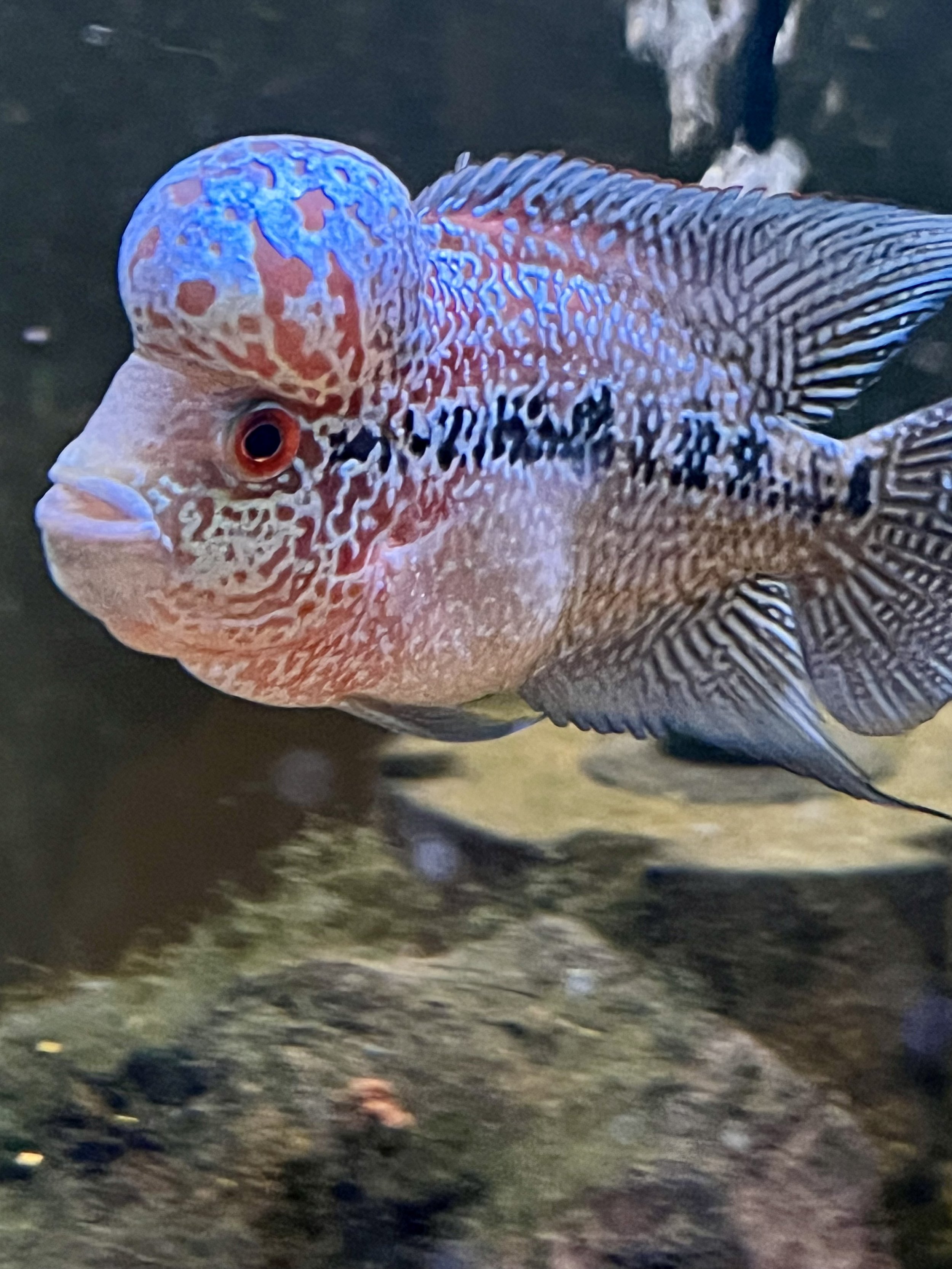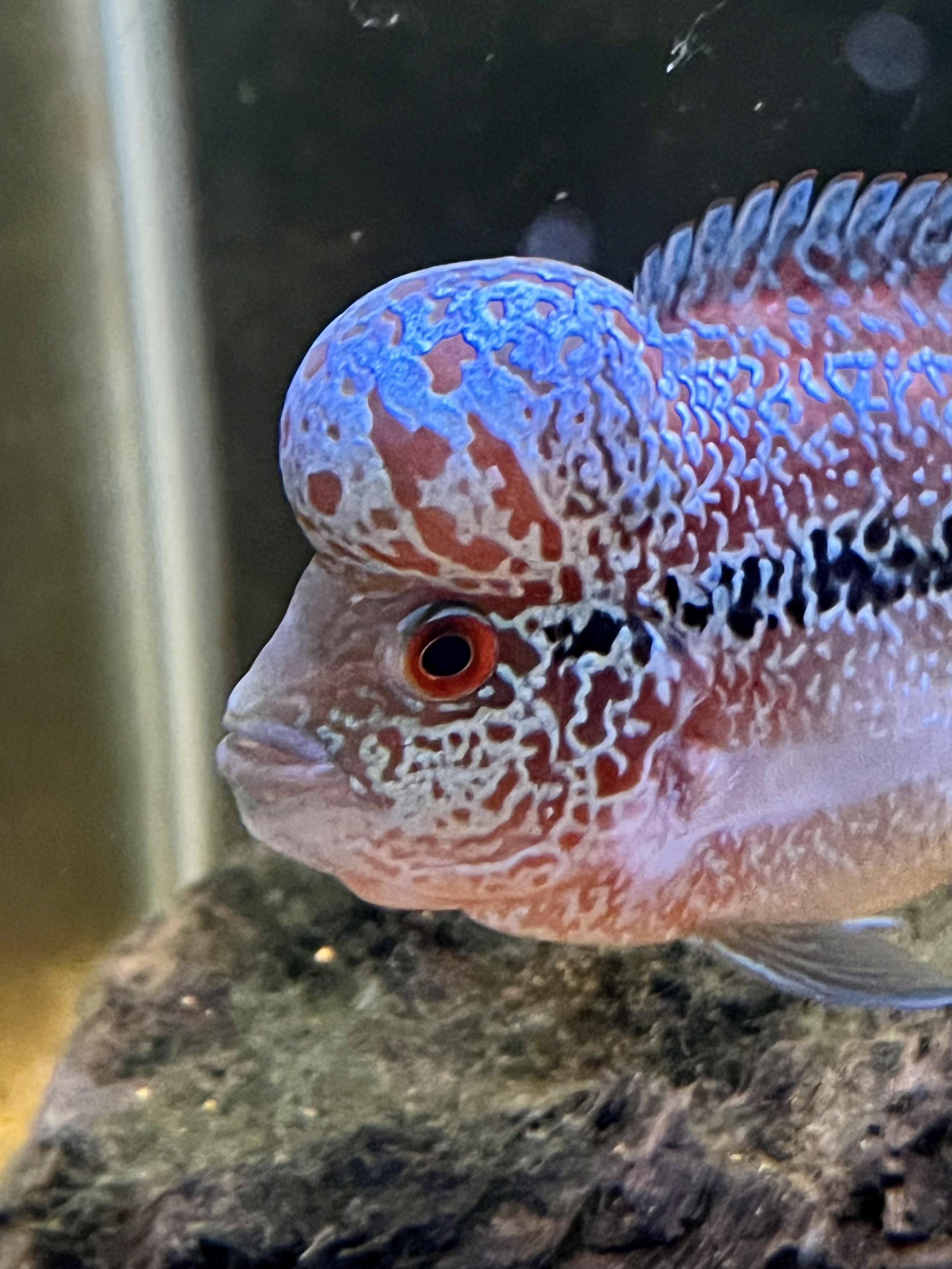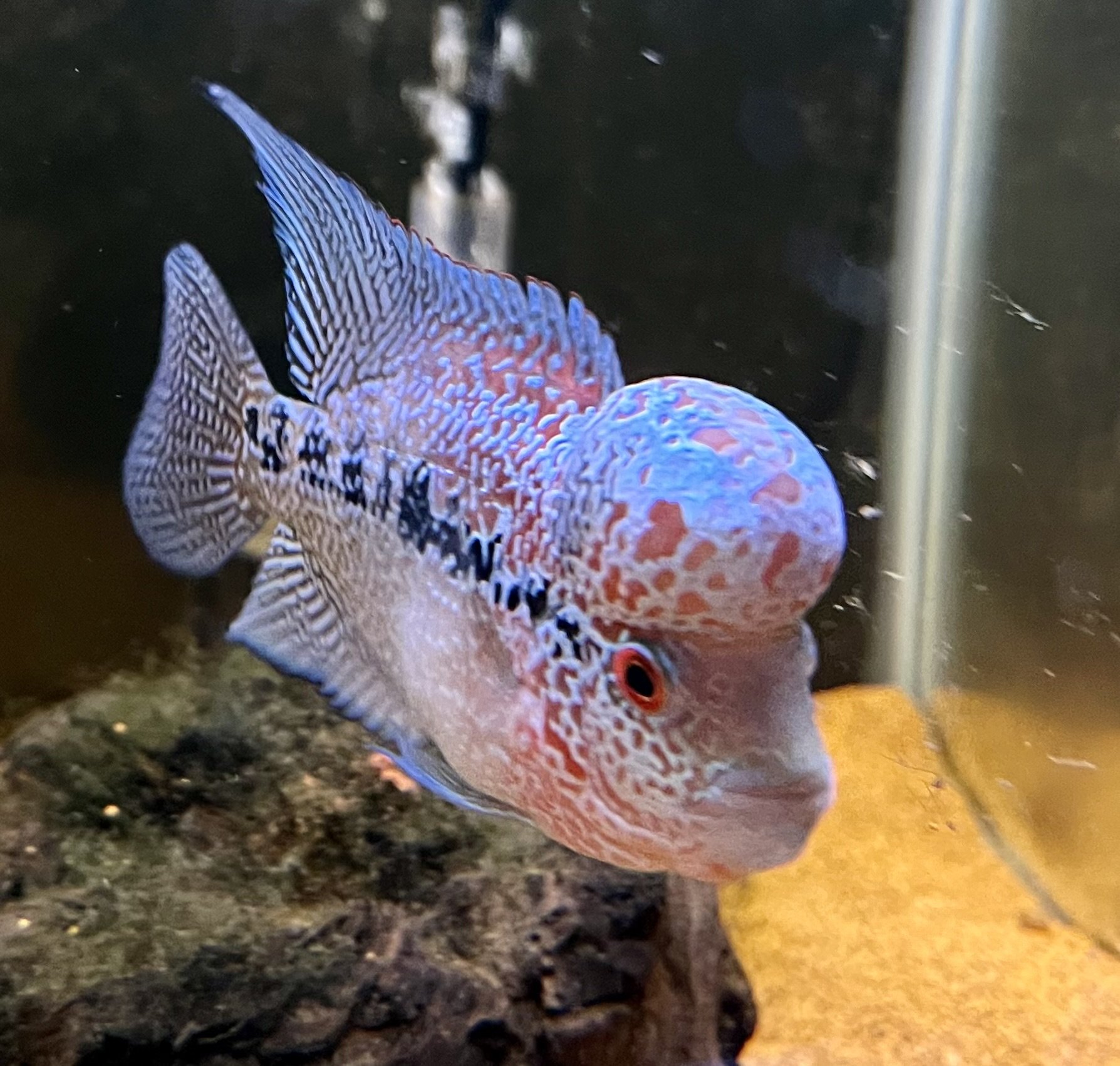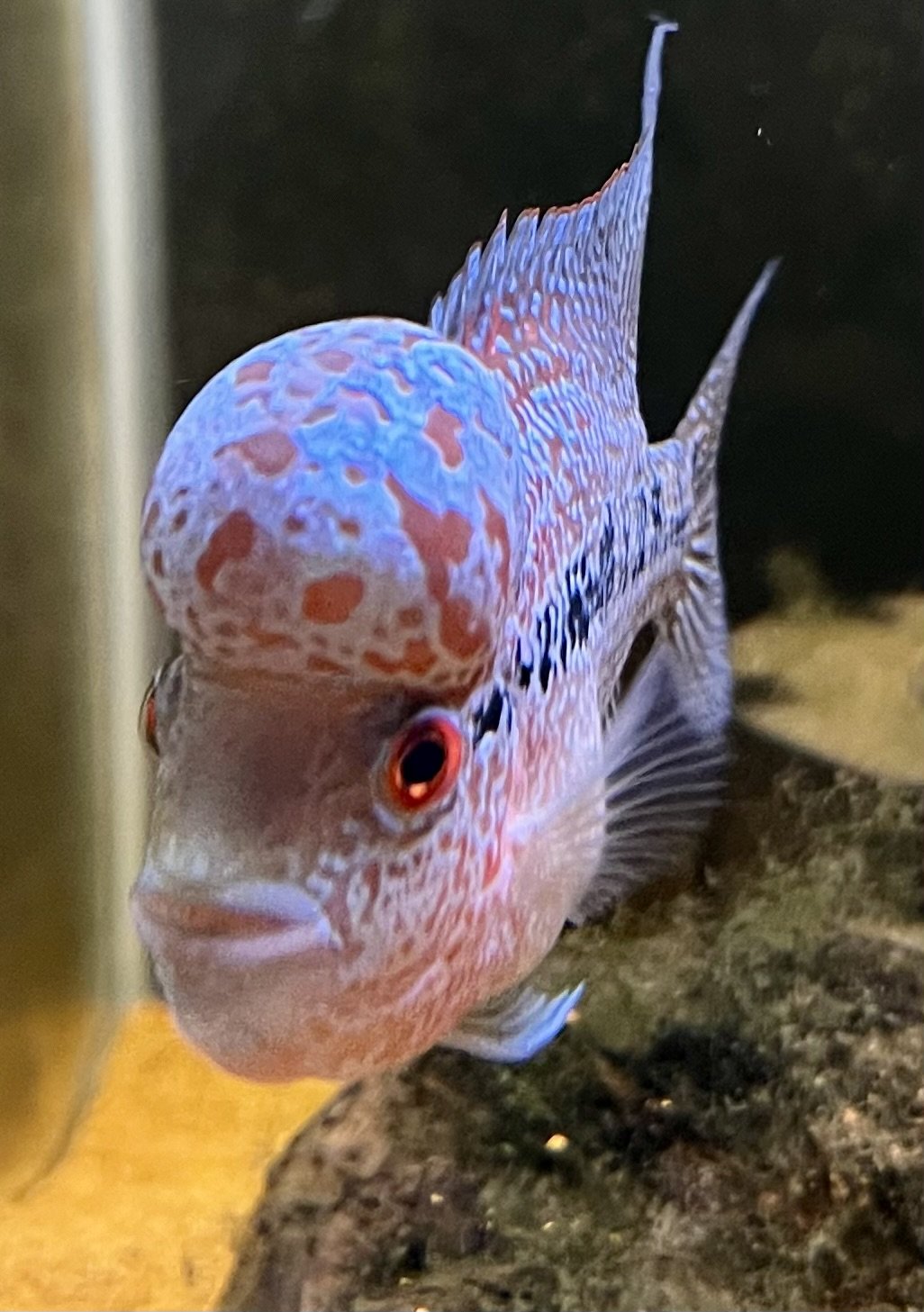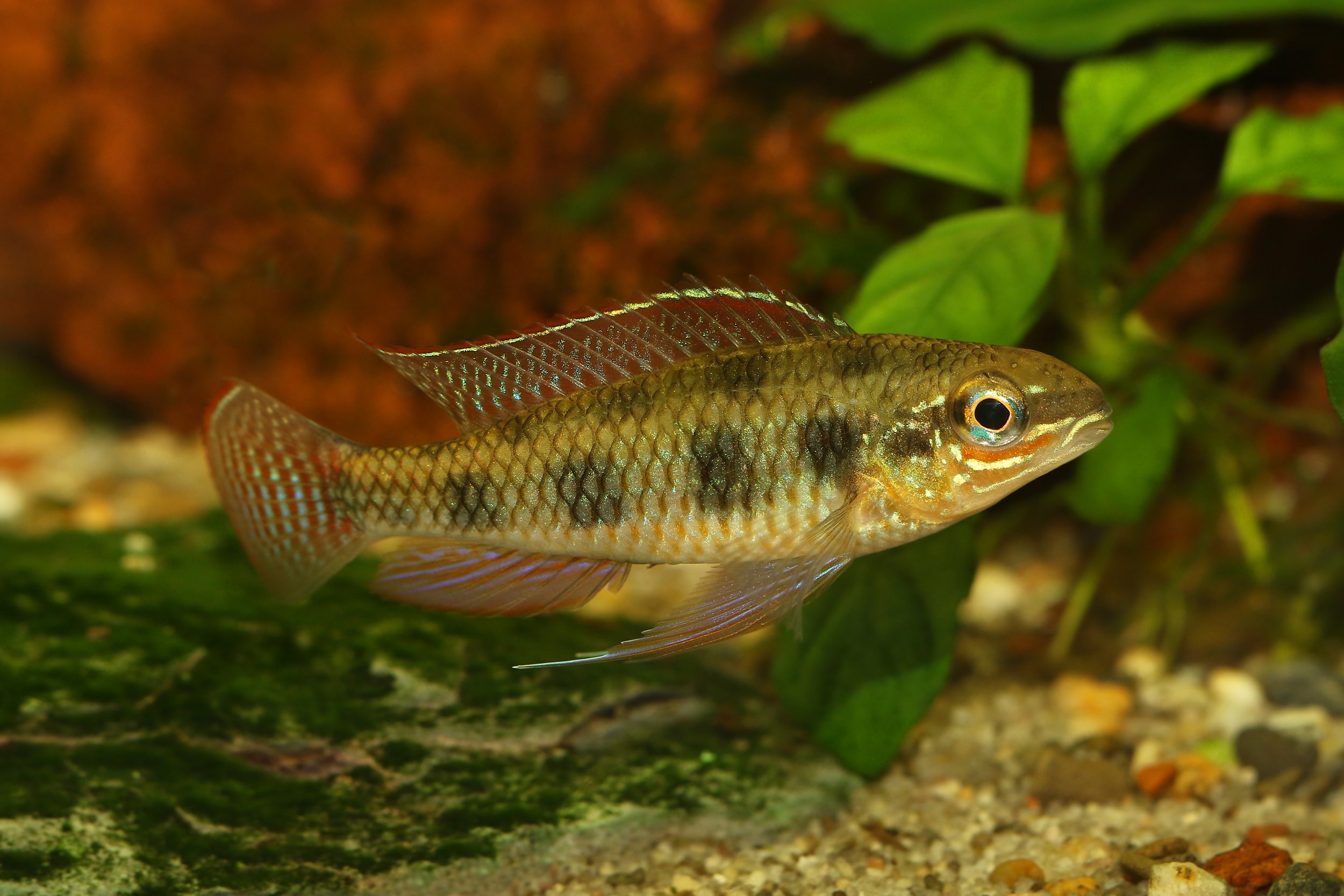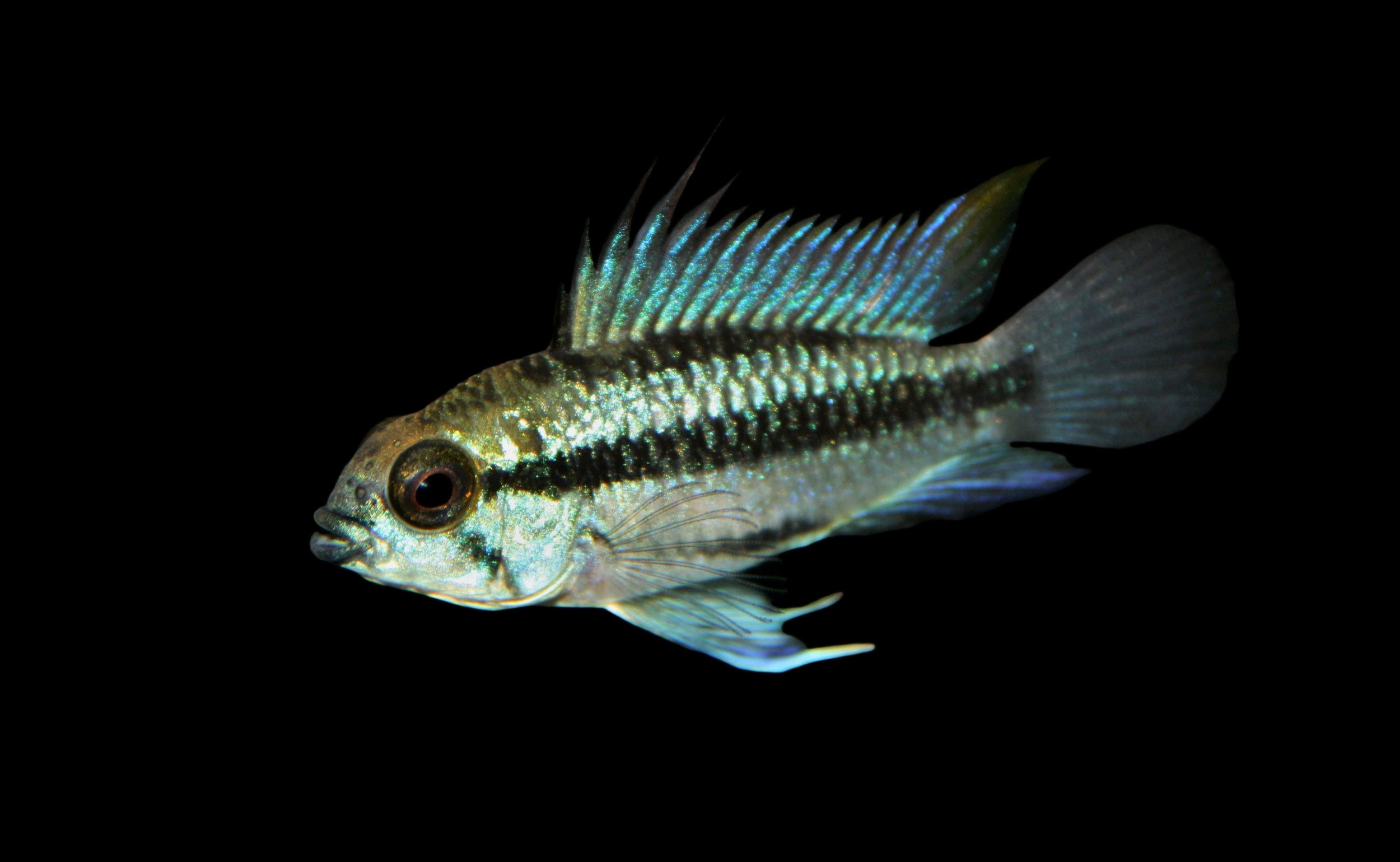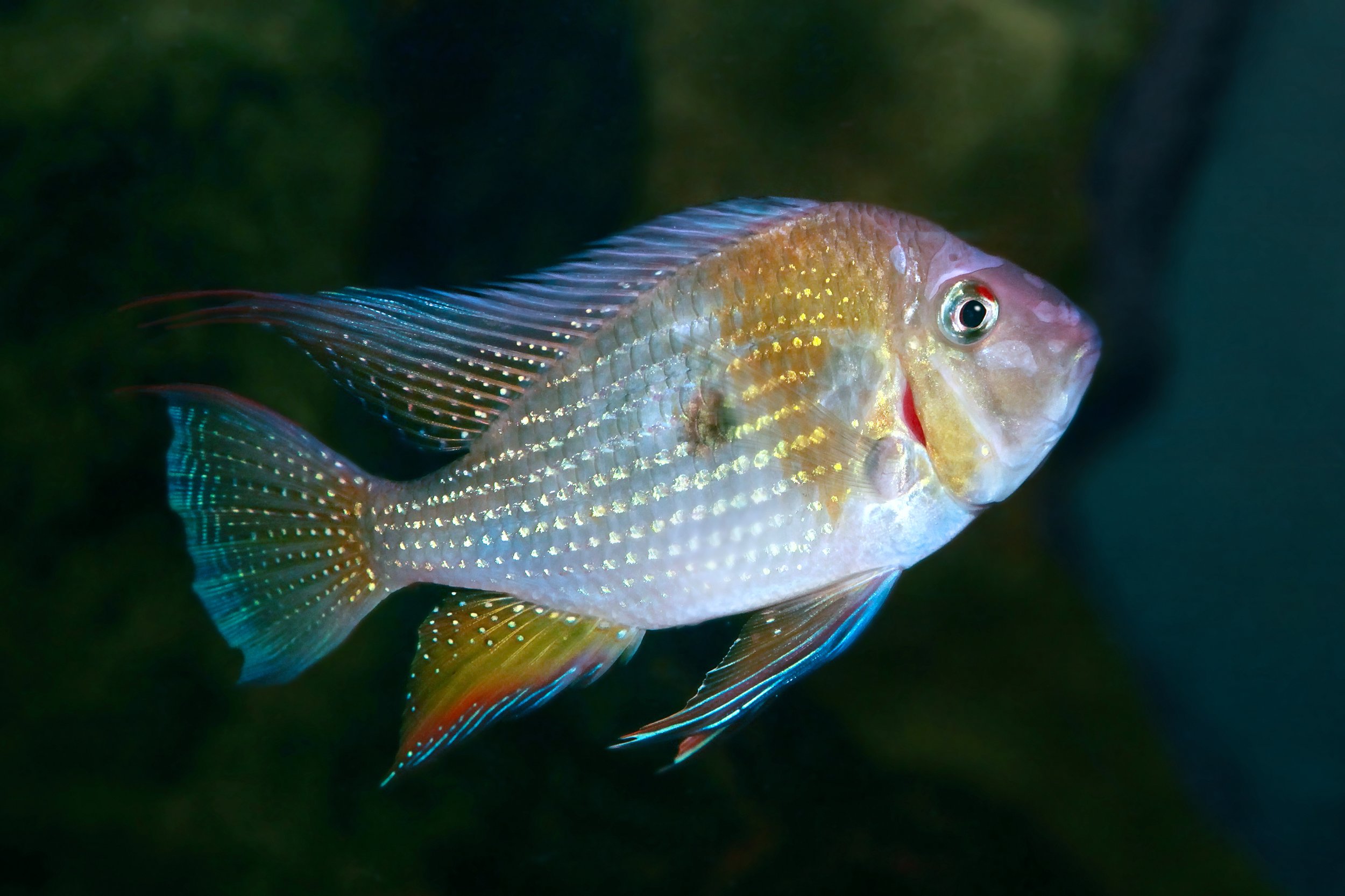 Image 1 of
Image 1 of


German Blue Ram
The German Ram Cichlid, scientifically known as Mikrogeophagus ramirezi, is one of the most colorful and popular dwarf cichlid species in the aquarium hobby. Often referred to as the German Blue Ram or simply Ram Cichlid, this species is native to the slow-moving waters of the Orinoco River basin in Venezuela and Colombia. It is prized for its vibrant colors, small size, and peaceful temperament, making it a perfect choice for community tanks, especially for aquarists looking for a centerpiece fish that adds a splash of color.
Physically, the German Ram Cichlid is known for its striking appearance. The body is typically a brilliant blend of electric blue, yellow, and red hues, with males displaying more intense coloration than females. The body is adorned with iridescent blue spots and markings, which shimmer under aquarium lighting. The head and body often feature golden-yellow tones, with some individuals displaying a black vertical stripe across the eyes and another one along the dorsal fin. The fins are generally elongated and adorned with red or orange highlights, adding to the fish's overall beauty. Males tend to be slightly larger and more colorful than females, and adults typically reach about 2 to 3 inches (5 to 7.5 centimeters) in length.
In the aquarium, German Ram Cichlids thrive in well-planted tanks with plenty of hiding spots, such as driftwood, rocks, and dense vegetation. They prefer soft, sandy substrates that allow them to dig and forage naturally. Although they are generally peaceful, German Rams can become territorial, particularly during breeding, so it’s important to provide sufficient space and hiding places to reduce aggression. They do well in community tanks with other small, peaceful species, such as tetras, rasboras, and Corydoras catfish. However, they should not be housed with overly aggressive or fast-moving species, as they can become stressed.
Water parameters for the German Ram Cichlid should closely resemble their natural environment in the Orinoco basin. They prefer soft, slightly acidic to neutral water with a pH range of 5.5 to 7.0 and temperatures between 78 to 85°F (25 to 29°C). Rams are sensitive to poor water quality, so it is crucial to maintain clean, well-filtered water with regular water changes to keep them healthy. They also benefit from the addition of tannins, which can be achieved by using Indian almond leaves or driftwood to simulate their natural blackwater habitat.
Feeding German Ram Cichlids is relatively easy, as they are omnivorous and will accept a variety of foods. They thrive on a diet of high-quality flakes or pellets, supplemented with live or frozen foods such as bloodworms, brine shrimp, and daphnia. Providing a varied diet helps maintain their vibrant coloration and overall health.
Breeding German Ram Cichlids in captivity can be both challenging and rewarding. They are substrate spawners, and pairs often form monogamous bonds. During breeding, the female will lay her eggs on flat surfaces, such as rocks, leaves, or even the substrate. Both parents will take part in guarding the eggs and tending to the fry. The eggs hatch within 2 to 3 days, and the fry become free-swimming after about 5 to 7 days. The fry can be fed on infusoria or specially prepared fry food, followed by baby brine shrimp as they grow. It’s important to maintain optimal water conditions during breeding to ensure success.
Overall, the German Ram Cichlid (*Mikrogeophagus ramirezi*) is a stunning and peaceful species that brings a vibrant splash of color and personality to any freshwater aquarium. With proper care and attention to their specific needs, these beautiful fish can thrive in a community tank or a dedicated species setup, offering aquarists a rewarding experience as they observe the fascinating behaviors and captivating beauty of this popular dwarf cichlid.
The German Ram Cichlid, scientifically known as Mikrogeophagus ramirezi, is one of the most colorful and popular dwarf cichlid species in the aquarium hobby. Often referred to as the German Blue Ram or simply Ram Cichlid, this species is native to the slow-moving waters of the Orinoco River basin in Venezuela and Colombia. It is prized for its vibrant colors, small size, and peaceful temperament, making it a perfect choice for community tanks, especially for aquarists looking for a centerpiece fish that adds a splash of color.
Physically, the German Ram Cichlid is known for its striking appearance. The body is typically a brilliant blend of electric blue, yellow, and red hues, with males displaying more intense coloration than females. The body is adorned with iridescent blue spots and markings, which shimmer under aquarium lighting. The head and body often feature golden-yellow tones, with some individuals displaying a black vertical stripe across the eyes and another one along the dorsal fin. The fins are generally elongated and adorned with red or orange highlights, adding to the fish's overall beauty. Males tend to be slightly larger and more colorful than females, and adults typically reach about 2 to 3 inches (5 to 7.5 centimeters) in length.
In the aquarium, German Ram Cichlids thrive in well-planted tanks with plenty of hiding spots, such as driftwood, rocks, and dense vegetation. They prefer soft, sandy substrates that allow them to dig and forage naturally. Although they are generally peaceful, German Rams can become territorial, particularly during breeding, so it’s important to provide sufficient space and hiding places to reduce aggression. They do well in community tanks with other small, peaceful species, such as tetras, rasboras, and Corydoras catfish. However, they should not be housed with overly aggressive or fast-moving species, as they can become stressed.
Water parameters for the German Ram Cichlid should closely resemble their natural environment in the Orinoco basin. They prefer soft, slightly acidic to neutral water with a pH range of 5.5 to 7.0 and temperatures between 78 to 85°F (25 to 29°C). Rams are sensitive to poor water quality, so it is crucial to maintain clean, well-filtered water with regular water changes to keep them healthy. They also benefit from the addition of tannins, which can be achieved by using Indian almond leaves or driftwood to simulate their natural blackwater habitat.
Feeding German Ram Cichlids is relatively easy, as they are omnivorous and will accept a variety of foods. They thrive on a diet of high-quality flakes or pellets, supplemented with live or frozen foods such as bloodworms, brine shrimp, and daphnia. Providing a varied diet helps maintain their vibrant coloration and overall health.
Breeding German Ram Cichlids in captivity can be both challenging and rewarding. They are substrate spawners, and pairs often form monogamous bonds. During breeding, the female will lay her eggs on flat surfaces, such as rocks, leaves, or even the substrate. Both parents will take part in guarding the eggs and tending to the fry. The eggs hatch within 2 to 3 days, and the fry become free-swimming after about 5 to 7 days. The fry can be fed on infusoria or specially prepared fry food, followed by baby brine shrimp as they grow. It’s important to maintain optimal water conditions during breeding to ensure success.
Overall, the German Ram Cichlid (*Mikrogeophagus ramirezi*) is a stunning and peaceful species that brings a vibrant splash of color and personality to any freshwater aquarium. With proper care and attention to their specific needs, these beautiful fish can thrive in a community tank or a dedicated species setup, offering aquarists a rewarding experience as they observe the fascinating behaviors and captivating beauty of this popular dwarf cichlid.
The German Ram Cichlid, scientifically known as Mikrogeophagus ramirezi, is one of the most colorful and popular dwarf cichlid species in the aquarium hobby. Often referred to as the German Blue Ram or simply Ram Cichlid, this species is native to the slow-moving waters of the Orinoco River basin in Venezuela and Colombia. It is prized for its vibrant colors, small size, and peaceful temperament, making it a perfect choice for community tanks, especially for aquarists looking for a centerpiece fish that adds a splash of color.
Physically, the German Ram Cichlid is known for its striking appearance. The body is typically a brilliant blend of electric blue, yellow, and red hues, with males displaying more intense coloration than females. The body is adorned with iridescent blue spots and markings, which shimmer under aquarium lighting. The head and body often feature golden-yellow tones, with some individuals displaying a black vertical stripe across the eyes and another one along the dorsal fin. The fins are generally elongated and adorned with red or orange highlights, adding to the fish's overall beauty. Males tend to be slightly larger and more colorful than females, and adults typically reach about 2 to 3 inches (5 to 7.5 centimeters) in length.
In the aquarium, German Ram Cichlids thrive in well-planted tanks with plenty of hiding spots, such as driftwood, rocks, and dense vegetation. They prefer soft, sandy substrates that allow them to dig and forage naturally. Although they are generally peaceful, German Rams can become territorial, particularly during breeding, so it’s important to provide sufficient space and hiding places to reduce aggression. They do well in community tanks with other small, peaceful species, such as tetras, rasboras, and Corydoras catfish. However, they should not be housed with overly aggressive or fast-moving species, as they can become stressed.
Water parameters for the German Ram Cichlid should closely resemble their natural environment in the Orinoco basin. They prefer soft, slightly acidic to neutral water with a pH range of 5.5 to 7.0 and temperatures between 78 to 85°F (25 to 29°C). Rams are sensitive to poor water quality, so it is crucial to maintain clean, well-filtered water with regular water changes to keep them healthy. They also benefit from the addition of tannins, which can be achieved by using Indian almond leaves or driftwood to simulate their natural blackwater habitat.
Feeding German Ram Cichlids is relatively easy, as they are omnivorous and will accept a variety of foods. They thrive on a diet of high-quality flakes or pellets, supplemented with live or frozen foods such as bloodworms, brine shrimp, and daphnia. Providing a varied diet helps maintain their vibrant coloration and overall health.
Breeding German Ram Cichlids in captivity can be both challenging and rewarding. They are substrate spawners, and pairs often form monogamous bonds. During breeding, the female will lay her eggs on flat surfaces, such as rocks, leaves, or even the substrate. Both parents will take part in guarding the eggs and tending to the fry. The eggs hatch within 2 to 3 days, and the fry become free-swimming after about 5 to 7 days. The fry can be fed on infusoria or specially prepared fry food, followed by baby brine shrimp as they grow. It’s important to maintain optimal water conditions during breeding to ensure success.
Overall, the German Ram Cichlid (*Mikrogeophagus ramirezi*) is a stunning and peaceful species that brings a vibrant splash of color and personality to any freshwater aquarium. With proper care and attention to their specific needs, these beautiful fish can thrive in a community tank or a dedicated species setup, offering aquarists a rewarding experience as they observe the fascinating behaviors and captivating beauty of this popular dwarf cichlid.

